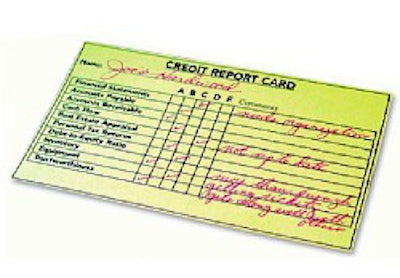

Your business needs to borrow money. Maybe it is a short-term situation—you need funds to cover day-to-day business needs until you receive payment for that last big flooring project. Or, maybe your money needs are long-term—you are upgrading your business and need to purchase more equipment and pay overtime. Whatever your financial need, there is an institution out there to meet your needs; however, the trick is finding the right one for you. The banking industry is undergoing significant restructuring these days. Big banks are merging to create larger financial institutions, and smaller banks are becoming more specialized in their communities. In choosing a bank,you need to consider the many different services you'll need in the next few years. As a small business,it is almost always better to centralize your banking activity with one bank, rather than spreading the business among two or more banks. To do this, the first step is to match your business' specific financial needs with an institution that provides you with personal attention, services and options best suited to your business size.
More than just checking accounts
When we think of banks, the image of tellers and checking accounts and loans comes to mind. But,today's banks provide many more services, depending on their size and market focus. Will your business need to take MasterCard and Visa? These are merchant account services, made available by many of the larger banks. Will you be exporting any products? Banks can provide letters of credit and foreign exchange services to support your international business. Does your business collect money by mail from all over the country? Your bank can provide cash management services, such as lock boxes,which are centralized cash-collection points. Think about what you are going to need down the road,and factor those ideas into your decision.
The right loan for you
There are many variables that go into a bank's decision to lend you money. For now, we'll assume your company is eligible and discuss some of the available lending alternatives: short-term credit facilities(credit lines and variations thereof) and longer-term credit facilities (installment loans, revolving credit/term loans).
Short-term credit facilities
To banks, short-term means less than one year, and these funds are extended to businesses to pay salaries, suppliers and other day-to-day business needs while awaiting payment from customers. These also are referred to as working capital loans.
A line of credit is a credit facility made available for a one-year period. You can borrow up to the designated limit and repay as you wish during the course of the year. Let's say you just completed a big project for a customer, but you have not yet received payment. In the meantime, however, you need to pay your staff, so you would borrow the amount you need under the line of credit and repay it when you get paid by your customer.
When talking about credit lines, there are some distinctions to keep in mind. The amount available under a line of credit is the maximum amount you can borrow at anytime. What you actually borrow under that line is the outstanding amount, or loan amount. So, if the bank grants you a$50,000 line of credit, $50,000 is the maximum amount you can borrow. If you draw down $10,000 under this line, that means that you have a loan of $10,000, or that $10,000 is outstanding under the line. In this example, you would be able to borrow up to $40,000 more.
Each bank operates a little differently;but, when you borrow under the lines,each amount will be documented by a note (essentially an IOU). Interest will be due every 30, 60 or 90 days. Under this type of line, bankers expect what is called a cleanup month one time during the year, when you are paid up in full and have nothing outstanding under the line. Sometimes, this cleanup month occurs when it's least convenient for your company. Talk to your banker ahead of time so there are no surprises.
The purpose behind the cleanup is to prove that your need is for working capital, as opposed to more permanent capital. Ask your banker about this cleanup provision. When the one-year period comes to an end, it is time to discuss renewing the line of credit with your banker. The bank will review your financial statements for the year and make the decision based on your financial figures, as well as your history as a borrower. Assuming there are no surprises,your line of credit should be renewed for another year.
An unsecured (no collateral pledged) line of credit usually is documented by a simple letter of agreement, in which the bank agrees to make funds available up to a certain amount at a particular interest rate. Most interest rates are based on the prime rate, which is the rate at which the largest banks lend money to corporate customers. You can find the prime rate in the Wall Street Journal or in the business section of your local paper. If the line of credit is secured, there is more documentation that pertains to the collateral.
Some banks make available overdraft lines to your checking account. This means that if you overdraw the account,the bank automatically will make a loan up to the approved amount. Overdraft lines are not intended to be used for general funding purposes; instead, they are to protect you from occasional bounced checks. They are expected to be repaid in a short period of time.
Longer-term credit facilities
Banks may classify medium-term (one- to three-year) and long-term (four- to seven year) loan periods, or they may just call anything over a year a term loan. Term loans are designed to finance capital needs that do not pay for themselves in a short period of time. The purchase of equipment, for example, can be financed by a term loan. In almost all cases, any term borrowings by small businesses need to be secured by collateral. While banks may be comfortable lending for working capital purposes, they are more wary of extending the time horizon when you're still building your business. Let's take a look at some examples of term facilities that may be offered by banks.
Installment loans are loans made for the purchase of equipment, for example,and have a fixed repayment schedule over a three- to five-year time period. The loan will be secured by the equipment, a fixed interest rate will be applied, and you will pay equal amounts on a monthly basis over the designated time period(like a typical car loan). The alternative to buying equipment and financing its purchase is to lease the equipment.
Revolving credit/term loans are lines that allow the company to borrow and repay (similar to a line of credit) over a two- to three-year period. At the end of that time, whatever is outstanding converts to a term loan and is repaid on a monthly or quarterly basis over the next three to four years. While the mechanics may be similar to straight lines of credit,the difference is that you will be operating under a loan agreement, where you will need to comply with a number of financial covenants (requirements) each quarter. If you violate the loan agreement, the bank may call the loan, and you will have to repay everything immediately.
You need to have established a good track record before a bank will make this type of loan available, since the bank is projecting that you can manage credit over a longer time period. That's why these loans are a popular credit option for companies that are more established. They are usually made available when a company is undergoing a lot of growth and its working capital needs have accelerated dramatically.
What do you need?
To obtain any of the credit facilities we've mentioned so far, you first need to prepare a credit application. In addition,the bank will ask for your company's financial statements (usually for the past three years), a list of accounts payable(amounts owed to your suppliers and vendors) and accounts receivable(amounts due to you from your customers), a detailed cash-flow statement,real estate appraisals (if appropriate),and any other documentation relevant to your situation. In addition, you may be asked to present your personal tax returns, especially if you are asked to guarantee the loan.
Credit scoring is a mathematical model that statistically analyzes a business's financial condition and the owner's personal credit. The resulting score is used to decide whether you should be granted credit. Credit scoring came about as a way to systematize lending to small businesses.
The process serves to weed out companies that are not creditworthy and to approve those that are good credit risks. Many companies fall into the gray area in the middle; in those cases, a bank representative will evaluate the company's application personally. The thing to remember is that the larger banks are not necessarily going to give you anytime. They may be happy to lend you money—if you are creditworthy, that is—but they do not have time to devote to getting to know you as well as a community bank officer would. Some of the smaller banks use credit scoring as well,but your loan application will likely be reviewed by a loan officer.
This is one of the trade-offs you need to consider when deciding between large versus small banks. As a small company,you may get lost in the shuffle of a large bank. But larger banks can provide many benefits as your business grows. Banks are in business to make money, and the reality is that the return from small business loans and fees from checking accounts do not usually constitute a profitable piece of business for the larger banks. Things like credit scoring have actually helped small businesses by creating a systematic way to evaluate small business loans. The process has reduced the labor-intensive aspects of credit review, and banks can review a greater number of applications.
While the mathematical approach of credit scoring is used by many banks,both large and small, a traditional review of your company evaluates the same types of things. Banks want you to have been in business for two to three years. They will initially want to secure everything to protect themselves. For example, they may take a lien on your assets (a collateral pledge on what you own) and ask for your personal guarantee. If the company's debt-to-equity ratio is greater than 3 to 1 (meaning you're carrying too much debt), they'll probably turn you down and refer you to a finance company. Banks expect to be paid back through the cash flow of the business,and they also look to a secondary source of repayment (for example, selling off the assets you've pledged as collateral).
Finding the bank
If you don't have a business banking relationship and don't know where to turn,talk to other business owners in your network for referrals, or ask for help from your local Chamber of Commerce. If you're given a specific loan officer's name,call and make an appointment. If you don't have a name, it might be worthwhile to just show up at the designated branch where you would want to do business and ask to speak to the branch manager. That person will then direct you to someone who will look after your business.
Make sure your loan is housed in a branch or service center that handles other businesses of the same size. You don't want your company to get lost in the shuffle because it is a fraction of the size of other firms. Also, cultivate relationships with more than one person at your bank. If your main contact leaves and it is time to renew your line of credit, the new loan officer will be starting from scratch and won't have a history with you.
A small manufacturing company we know faced this situation when it needed to borrow from its local bank for a production run. The line of credit was about to expire, and the bank officer who originally signed the credit line had been transferred to a larger branch. The new loan officer was reluctant to automatically renew the line, because he was unfamiliar with the company. Fortunately, this small business owner had all of the proper documentation ready to present to the bank, immediately made an appointment to see the banker, and was able to seamlessly borrow to pay for the production cycle.
There are a number of other financial institutions that walk and talk and act like commercial banks, but are not. See the sidebar "Beyond banks," which describes some of these other non-bank lending institutions.
Another option
If your overall financial picture is jittery,but you have great customers, asset based lending may be a good option for obtaining money for your business. Asset based lending is used when you have high-quality assets—receivables, inventory, or equipment—you can pledge as collateral for a loan. It is a frequently used funding alternative for many small business owners, particularly those who may otherwise be turned down for bank loans. The good news is that your company may not be bankable, but it is finance able. That is, the bank may not want to give you money, but there are other financial institutions that will.
The nature of these assets
Accounts receivable (sometimes called receivables) are the uncollected portions of sales you have made. For instance, if you sold $10,000 of product to a client on 30-day terms, it means that the customer will pay you $10,000 within30 days. During the time between the actual delivery of the product and the receipt of the $10,000, this sale is actually an account receivable, a short-term asset on your company's balance sheet. When you get paid, the receivable disappears,and you receive cash.
Inventory, product you hold for resale,is divided into three components: raw materials, work in process, and finished goods. There is a value placed on each of these components, depending on the actual goods and the marketability of the inventory. Equipment can be anything from a work van to a building to a computer network. Equipment is less frequently financed by asset-based lenders,but it is eligible collateral. Some asset based lenders also will advance your firm money against purchase orders, which are unfilled customer orders.
As an example, Azur Packaging Company is a box manufacturer that sells specialized packaging to pharmaceutical companies. It has $125,000 in receivables from various customers and needs to pay its paper supplier faster than it receives payment from the pharmaceutical customers. Azur goes to a commercial finance company and receives a loan pledged by those receivables as collateral. In essence, Azur is saying, "We have$125,000 coming in a month from now,but we need the money immediately to pay our suppliers. Give us a loan, and you'll be repaid as soon as we get paid."
Locating a lender
You sometimes will find asset-based lenders in banks, but commercial finance companies and credit companies specialize in this kind of lending. Two well known firms are GE Capital and The Money Store. In contrast to banks, these lenders are not as concerned about your company's profits, net worth, or debt burden. Instead, they collateralize high quality assets, such as receivables or inventory, and make loans against them. While the loans are granted based strictly on the quality of the collateral,they're looking for repayment from your company first, not a selling off of your collateral if you don't make good on the loan. They're making assumptions of timely payment and good credit on the part of your customers.
Terms of the loans
Asset-based loans can be made as short term loans secured by the receivables. These loans are virtually always more expensive than traditional bank loans. Why? Because your credit quality isn't as high, even though you have valuable collateral. Interest rates on these types of loan average at prime plus 3 to 5 percent, plus an origination fee of about 1 to2 percent. It's steep, but keep in mind the benefits the much-needed cash will bring your company.
The loans typically are made against receivables less than 60 days old—ones that are less risky and have a higher probability of being paid (see "Rules of thumb for eligible assets" sidebar). When you receive payment for the receivable,you pay the lender and that portion of your loan outstanding is paid down.
We recommend that you always first try to get a traditional bank loan, primarily because the interest rates will be much more favorable. If you're turned down because of shaky credit quality,ask your banker for referrals to asset based lenders. Your bank may have a department that does this type of lending, or, you may be referred to finance companies that specialize in asset-based lending. Asset-based lenders are much less likely to turn you away if your overall financial situation is shaky, and they'll take you if the quality of your collateral—the receivables, inventory, or equipment—is good.
What about a "factor"?
Factors are lenders who actually purchase your receivables at a discount and advance you about 80 percent of the discounted value in cash. Factors bear both the collection and credit risks of payment. For example, you may have$275,000 of receivables, which the factor discounts to $250,000. The factoring firm will purchase those receivables for$200,000 (80-percent advance rate in this case) and pay your company in cash. The factor then takes care of the bookkeeping and collections, and assumes all the losses on the uncollectible accounts, making their profit for taking the risk and providing these services to you.
Advance rates (the percentage of your receivables the factor gives you in cash)have a huge range, and may be anywhere from 70 to 95 percent of the value of the receivables. Factors' pricing is based on your sales volume, the average invoice size, the number of customers,the credit quality of your customers, and the terms of sale. For budgeting purposes, assume that you will be paying prime plus 5 percent, plus around 1 percent on the total volume for collections and insurance.
Companies in the apparel field are frequent customers of factors, since their receivables are their key assets. For example, let's say you're a clothing manufacturer. You've shipped your product on terms of net 30. If you need cash right away, think about selling these receivables to a factor. The factoring firm will do a check on your customers and make you an offer based on their creditworthiness. The trade-off is that you'll end up with less money than if you had waited for your customers to pay, but you'll have funds immediately .
Companies often start out with factors or other asset-based lenders because their traditional banking options appear limited. Once their overall credit quality improves, they inevitably move on to traditional banks, since the costs associated with asset-based lending is so much higher. As a result, there is a lot of turnover among the customers of these lenders.
Approaching an asset-based lender
When you approach an asset-based lender, have all of your documentation in place: invoices, shipping records,advance payments, etc. Once you become a client of an asset-based lender,expect frequent meetings—usually monthly. These lenders do not like surprises, so they keep on top of your finances as long as you have their money.
When you're shopping for a lender, call and ask for the officer who handles small business accounts. Introduce yourself and describe what you're looking for. Be prepared to answer questions about the type of customers you have and the average size of the receivable.
Where to find asset-based lenders and factors
Ask your banker for a referral. You may try your accountant or your Chamber of Commerce for suggestions. If you're in a position to choose, interview several lenders. Be sure to compare apples to apples for prices and services. Call the Commercial Finance Association at 212/594-3490, or visit www.cfa.com for a membership list. Finally,you can look under factors or finance companies in your local Yellow Pages.
Understand that working with a finance company or factor, while more expensive than a bank, may be the only way you fund the growth of your company. Think of it as a rite of passage, and know that it is money well spent to move your business to the next level.
Beyond banks
• Thrifts, savings & loan institutions: Traditionally real estate lenders; now doing more commerciallending.
• Credit unions: Increasingly available; offer many of the consumer banking services of commercialbanks.
• Brokerage firms: Larger ones are creating full-service loan and depository services for small business customers.
• Credit card companies: More are setting up full-service small business divisions.
• Commercial finance companies: Traditionally asset-based lenders; now increasing commerciallending.
Rules of thumb for eligible assets
Asset-based loans are made against eligible assets, meaning those that are not past due or risky. Different advance rates are applied depending on the collateral. Some rules of thumb are:
• 75 to 80 percent advance against eligible receivables• 25 to 50 percent advance against eligible inventory• 10 to 50 percent advance against equipment• Up to 75 percent advance against real estate
For example, Azur Packaging Company has $115,000 in eligible receivables; $10,000 are not eligiblebecause they are 90 days past due. The finance company lends Azur $86,250, which represents a75 percent advance against the $115,000 in eligible receivables.






























